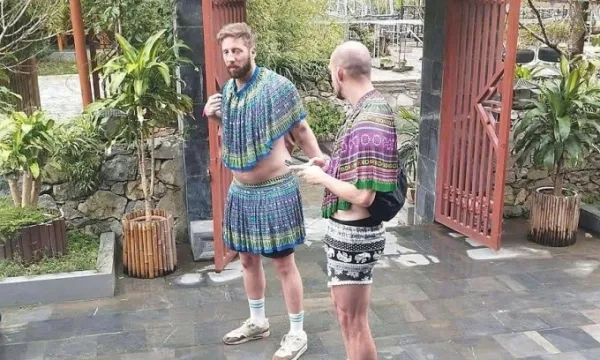
Lo A Loi, a 29-year-old H’Mong man working in the tourism sector in Sa Pa, said the trend began surfacing on TikTok around six months ago.
“Foreign men wearing H’Mong skirts at tourist sites are becoming more common. But this is a misuse of our traditional costume.
“Some people clearly know better, yet they encourage tourists, especially men, to wear H’Mong women’s skirts as a gimmick to film videos and drive social media engagement.”
For many H’Mong, their traditional clothing has deep cultural and spiritual significance.
“Our costumes are clearly defined by gender and closely tied to honor, rituals and identity,” Loi explained.
“It hurts us to see them use the traditional costume flippantly.”
Dr. Tran Huu Son, director of the Institute for Applied Research in Culture and Tourism, said H’Mong dresses are cultural symbols.
“The design tells you whether someone belongs to the Black H’Mong, White H’Mong or Lenh H’Mong.”
Traditionally, skirts are reserved for women, except in rare cases, such as for male shamans.
In daily life, the H’Mong might wear modern clothing, but during funerals both men and women are dressed in or buried with skirts to symbolize a return to their roots.
|
Two male tourists wearing H’Mong dresses in Ha Giang. Photo courtesy of Lo A Loi |
Vu Huong, a H’Mong tour guide and author, was at pains to stress the importance of cultural interpretation.
“Tourism workers should explain the history and significance of the skirt to visitors, rather than offering it to men as a joke.
“That’s not how you share culture.”
But some others in the tourism industry took a more relaxed stance.
Dr. Trinh Le Anh, head of the event management department at the University of Social Sciences and Humanities in Hanoi, warned that wearing H’Mong skirts “for fun” without understanding their meaning could easily cross the line into cultural insensitivity.
“There’s a fine line between honoring and mocking a culture.
“When these images go viral as jokes or trends, a meaningful cultural symbol is reduced to a prop.”
Anh recalled wearing ethnic costumes in Japan, Korea and Bhutan but always with clear guidance and respect.
“I’ve never worn women’s traditional clothing, not even for a photo.
“Culture isn’t something to cosplay carelessly.”
As a H’Mong herself, Huong advocated for “cultural openness within boundaries,” warning against distortions that harm a community.
While she acknowledged that the H’Mong have modernized aspects of their homes for tourism, she emphasized that the women’s skirt remains sacred.
“The skirt is not for men, except when they have passed on to the other world.”
She called for government policies to support the preservation of ethnic cultures, stressing that culture is the foundation of sustainable tourism.
Anh said tour guides and operators should receive proper training and be equipped with in-depth knowledge of local cultures.
Besides, local communities must be empowered to co-design tourism experiences deciding who wears what, in what context and how cultural elements are interpreted, he said.
Local authorities need to establish a code of conduct for cultural tourism to guide the behavior of both visitors and tourism workers, he added.